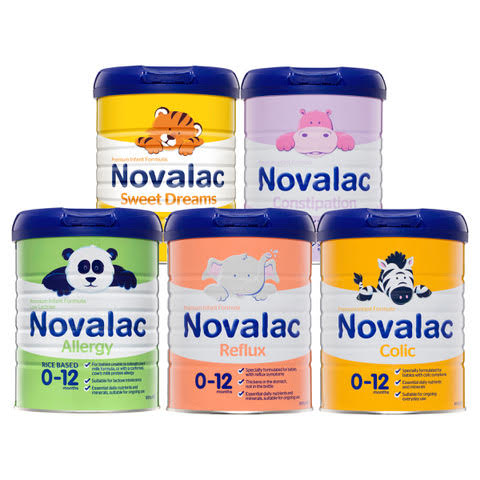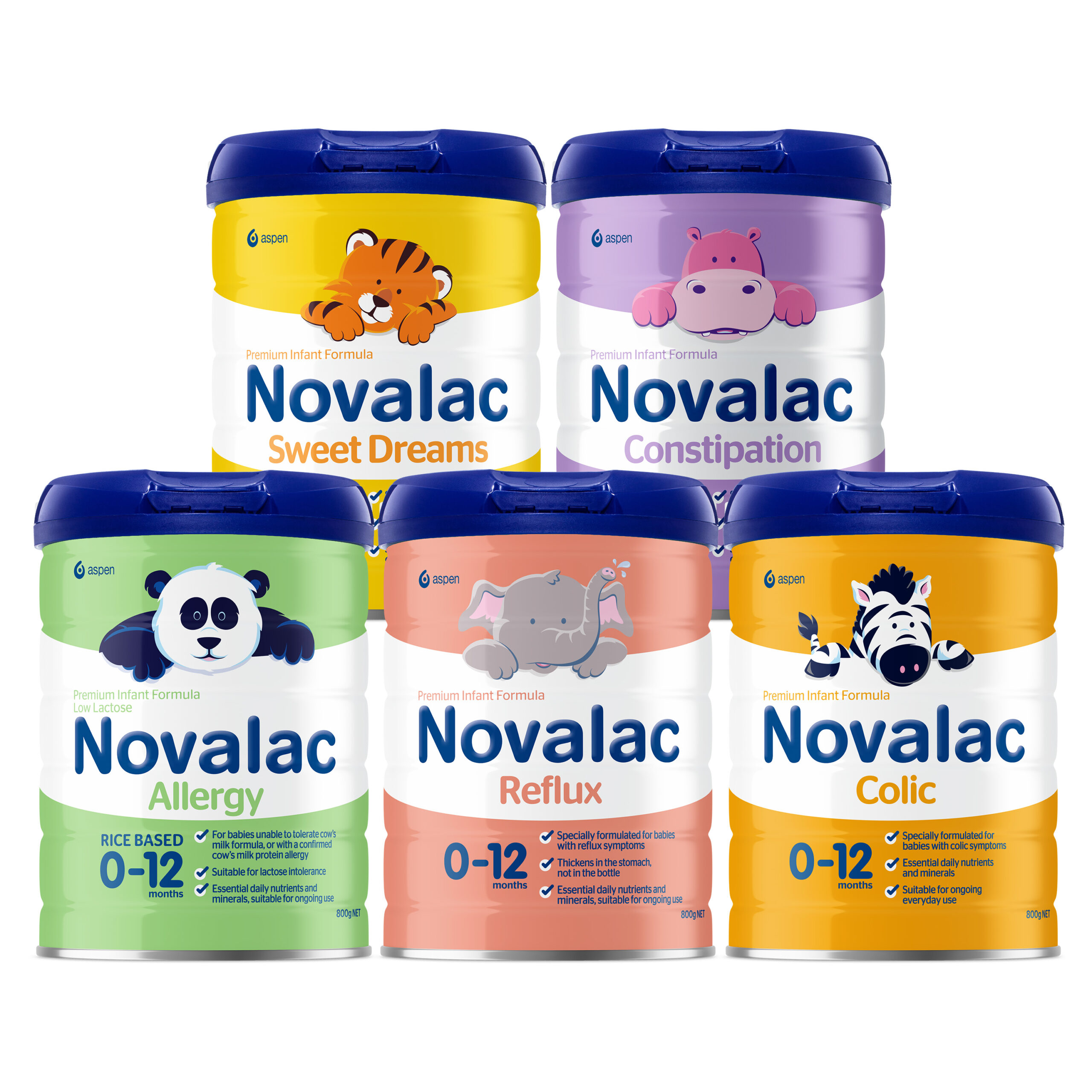Frequently Asked Questions
About Novalac infant formula
Yes, Novalac Infant Formulas (0-12 months) are nutritionally complete for babies up to 12 months of age. Babies aged over 6 months should be offered solid food in addition to infant formula.
Novalac is not currently available in New Zealand, however can be purchased online through major retailers in Australia.
Yes. It is a requirement by Food Standards Australia and New Zealand (FSANZ) that all infant formulas are gluten free.
Novalac milk is produced in Europe: strict testing and procedures are adhered to at all times, ensuring that the finished products are of the outmost quality, for every production.
Novalac formulas that contain milk are made with fresh milk collected in an area of 200km around the production site.
Novalac formulas are not certified organic, and cannot be compared to other organic formulas available. However Novalac formulas are manufactured according to strict testing and procedures are adhered to at all times, ensuring that the finished products are of the outmost quality, for every production.
Novalac formulas are fortified with iron. This is to ensure that babies receive all the iron they need after the iron stores they build up before birth run low. The amount of iron in Novalac formulas is in line with Food Standards Australia and New Zealand (FSANZ) requirements. This is not expected to cause constipation in your baby. If you are concerned, see your healthcare professional for advice.
All Novalac infant formulas are nutritionally complete, nourishing your baby with essential daily nutrients and minerals. Babies aged over 6 months should be offered solid food in addition to infant formula.
The Novalac infant formula range is suitable for ongoing everyday use after symptoms have resolved. So even when your baby's symptoms are being managed successfully with one of the Novalac specialised range and their symptoms have resolved or eased, you may continue to use Novalac until they are 12 months of age.
However it’s important to note that Novalac Colic, Constipation, Reflux and Allergy are specialised formulas for babies with specific symptoms of feeding conditions (e.g. colic, constipation, reflux or cow’s milk protein allergy). These formulas are not intended for general use and should only be used under medical supervision.
Novalac Colic – France
Novalac Reflux – France
Novalac Constipation – France
Novalac Sweet Dreams – France
Novalac Allergy – Spain
Infant nutrition
Breastfeeding is best. Breast milk is best for babies. Professional advice should be followed before using an infant formula. Introducing partial bottle feeding could negatively affect breastfeeding. Good maternal nutrition is preferred for breastfeeding and reversing a decision not to breastfeed may be difficult. Infant formula should be used as directed. Proper use of an infant formula is important to the health of the infant. Social and financial implications should be considered when selecting a method of feeding.
Babies have specific nutrient and energy requirements at each stage of their growth and development. Infant formulas are formulated for babies aged 0–6 months. These formulas are designed to replace breast milk for infants who are not breastfed and provide all the nutrients, energy and fluids that infants need at this stage of their development.
As babies grow, their energy and nutrient requirements increase. Follow-on formulas are designed to meet the growing nutritional needs of babies 6–12 months of age. It’s recommended that solid foods are introduced when your infant is ready, at around 6 months, but not before 4 months to help provide the extra nourishment that babies need at this stage of their development.
It’s important to remember that breast milk is best for babies, and it’s also recommended that babies be exclusively breastfed until they are around 4–6 months old.1
If you’re ready to move on from exclusively breastfeeding, a premium formula such as Novalac may be used. When you first introduce formula-feeding to your baby, it may take some time for them to get used to the bottle, and for your body to adapt to the reduced demand for breast milk. Gradually switching one breast feed per day for a bottle feed will give both of you time to adapt.
Professional advice should be followed before using an infant formula. Introducing partial bottle feeding could negatively affect breastfeeding. Good maternal nutrition is preferred before breastfeeding and reversing a decision not to breastfeed may be difficult.
Reference: 1. Australiasian Society of Clinical Immunology and Allergy (ASCIA) Guidelines: Infant Feeding and Allergy Prevention 2016.
Most of the time it's fine to change formulas as long as you keep to the same type. For example, if you’re using an everyday infant formula designed for babies 0–6 months, changing to another brand of everyday infant formula for babies aged 0–6 months will not harm your baby, although their body may take some time to adapt. For example, at first you might notice a change in your baby’s bowel movements, or they may be reluctant to accept the unfamiliar taste, but this is usually temporary.
However, if your baby is on a specialised or pediatrician-recommended formula we would recommend that you check with your healthcare professional before switching brands or types.
It’s recommended that solid foods are introduced when your infant is ready, at around 6 months, but not before 4 months, to help provide the extra nourishment that babies need at this stage of their development.
Infant formulas are designed to replace breast milk if you choose not to breastfeed or are unable to breastfeed, and solids should be introduced around 6 months of age in this case too. It’s important to note that ordinary cow’s milk, soy milk or other plant-based milks that are not specifically designed for babies are not recommended for babies under 12 months of age.
Preparing and storing Novalac
Follow instructions on the label exactly. Prepare bottles and teats as directed. Do not change proportions of powder except on medical advice. Incorrect preparation can make your baby very ill.
Always wash your hands before preparing a bottle. Each bottle should be prepared individually. Only use the measuring scoop provided. It is recommended that formula be used immediately after it is prepared.
 |
Wash the feeding bottle, cap, teat and any utensils to be used and sterilise them in boiling water. |
 |
Boil clean drinking water for 5 minutes and allow to cool to 40°C. Pour the required amount of water (see Feeding Guide) into the bottle. |
 |
Measure the correct quantity of formula (see Feeding Guide) into the bottle using the scoop provided. Always use one level scoopful per 30mL of water. |
 |
Secure the lid on the bottle and shake for at least 30 seconds until the powder is completely dissolved. Let cool to lukewarm temperature (37°C) without re-shaking. Test the temperature on your wrist before feeding. |
Formula should be consumed within one hour of preparation. Any formula left over after feeding should be discarded. Refer to product label for further instructions.
Store in a cool, dry place and protect from light. Use within 3 weeks of opening. Do not use after the ‘Use by’ date, which is on the base of the can.
Constipation
It depends. Most of the time, constipation in babies happens when they’re not drinking enough fluid. Babies can also become constipated for a short time after solids are introduced, while their body is adjusting. For formula-fed infants, cooled boiled tap water may be given in moderation if additional fluids are needed. Exclusively breastfed infants do not require additional fluids up to 6 months of age. Never dilute your baby’s formula if you are formula feeding.
If your baby’s constipation doesn’t resolve, it’s a good idea to see your healthcare professional to rule out any underlying issues.
Novalac infant formulas are fortified with iron. This is to ensure that babies receive all the iron they need after the iron stores they build up before birth run low. The amount of iron in Novalac formulas is in line with Food Standards Australia and New Zealand (FSANZ) requirements. This is not expected to cause constipation in your baby. If you are concerned, see your healthcare professional for advice.
Cow’s milk protein allergy
No. Lactose intolerance is different to cow’s milk protein allergy, and is an inability to digest lactose, the sugar found in milk. Lactose intolerance is not an allergic reaction and does not cause anaphylaxis, rashes or other allergy symptoms. Lactose-free formulas are based on cow’s milk with the lactose removed. Giving a baby with a confirmed cow’s milk protein allergy a standard lactose-free formula can result in an allergic reaction.
Goat's milk formula are not suitable for people with cow's milk allergy, and may cause severe allergic reactions (anaphylaxis).
Reference: Australasian Society of Clinical Immunology and Allergy. Cow’s milk (dairy) allergy. 2019.
Novalac Allergy is a premium evidence-based hydrolysed rice protein specialty infant formula. It is specifically developed for babies unable to tolerate formula containing cow’s milk protein, or with a diagnosed cow’s milk protein allergy.
When to see a doctor
A clinical study of Novalac showed that the symptoms of most feeding problems begin to improve after 1 week, but may take longer for some babies/conditions.1
With the exception of Novalac Allergy, if your baby's symptoms have not improved within a month, or if your baby's symptoms get worse, you should seek the advice of your healthcare professional 1.
If your baby has a confirmed cow’s milk protein allergy and is using Novalac Allergy, you should notice symptoms improve quite quickly. Symptoms like excessive crying and rash should improve within a month, but if your baby is underweight, it may take some time for them to catch up.2 If you’re concerned about your baby’s symptoms, or if they do not seem to be improving, see your healthcare professional for advice.
References:
1. Pina et al. World J Gastroenterol. 2008; 14(2):248–54 (Eden Study).
2. Vandenplas Y et al. Arch Dis Child. 2014; 99:933–6.
AF-07737

EVERY CHILD IS DIFFERENT
Every child's development and needs are different, especially when it comes to conditions that may impact on their everyday feeding habits. We are here to support you.
Which product is right for your child?
Learn more about our full range of products.
Need support or advice?
Contact our medical information line to talk to our team for product related questions.
Is it an infant feeding condition?
Learn about the symptoms of common infant feeding conditions.




